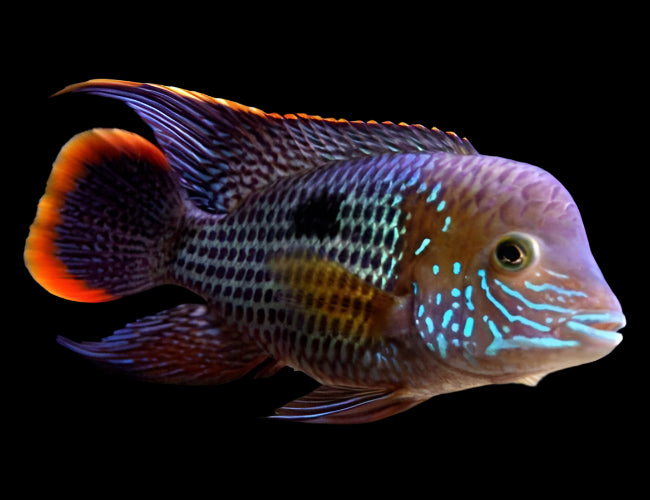Description
Green Terror Cichlid – A Striking Showpiece with Power and Personality
The Green Terror Cichlid (Andinoacara rivulatus) lives up to its name with its bold colors, powerful presence, and commanding personality. This stunning freshwater fish showcases shimmering green, turquoise, and blue hues, often accented with orange or white trim on its fins—making it one of the most visually impressive cichlids available.
Native to South America, Green Terrors are known for their territorial nature and are best suited for experienced aquarists who can provide ample space and compatible tank mates. When properly cared for, they grow up to 8–12 inches and can live for over a decade, becoming a true centerpiece of any large aquarium.
Key Features:
-
Coloration: Iridescent green and blue body with vivid fin highlights
-
Temperament: Semi-Aggressive, best kept with other fiesty cichlids
-
Size: Can reach 8–12 inches in adulthood
-
Tank Requirements: Minimum 55–75 gallons with strong filtration, structure, and open swimming areas
-
Diet: Omnivorous—thrives on high-quality pellets, live/frozen foods, and vegetables
-
Compatibility: Best with similarly sized, robust cichlids in a large tank
With their dazzling coloration and bold personality, Green Terror Cichlids are a dramatic and rewarding choice for aquarists ready to handle their powerful presence and complex behavior.
Click & Collect
Livestock will only be bagged once you arrive, or if you contact us in advance to request it ready beforehand.
Local Delivery
Order anything from our in-store range and have it delivered right to you.
-
Minimum spend: £50
-
Delivery up to 10 miles: £10
-
Delivery up to 25 miles: £20
Distances are measured “as the crow flies”, not by road.
Once your order is placed, we’ll be in touch to arrange a suitable delivery date and time.
Please note, delivery may take a little longer as we often group orders together to build an efficient delivery run.
Important: If you’re ordering a large aquarium, please ensure someone is available to help unload the van on arrival.
Dry Goods Delivery
-
DX Express: 1 working day, same-day dispatch before noon 0-75kg
-
Express Pallet: 1–3 working days 75-500kg
If you'd like to add more items to an existing order that hasn't yet been dispatched, please place a Click & Collect order and leave a note asking us to combine the orders.
Please note: We currently only dispatch parcels Wednesday to Friday.
Pre-Order
Want the full details? Check out our Terms & Conditions.
Livestock Delivery
Thursday Delivery – £24
-
Dispatched Wednesday afternoon
-
Delivered Thursday before 1pm
-
Order by Wednesday 12 noon
-
Minimum spend: £50
Friday Delivery – £24
-
Dispatched Thursday afternoon
-
Delivered Friday before 1pm
-
Order by Thursday 12 noon
-
Minimum spend: £50
Saturday Delivery – £29
-
Dispatched Friday afternoon
-
Delivered Saturday before 1pm
-
Order by Friday 12 noon
-
Minimum spend: £50
📦 Want to Add to an Existing Order?
No problem! Just place a Click & Collect order and leave a note asking us to link it with your original one (as long as it hasn’t been dispatched yet).
🛒 Dry Goods Now Included!
You can now include dry goods in your livestock delivery – perfect for topping up supplies in one go.
❄️ Please note: We can’t send frozen food with livestock – please order frozen items separately.
⚠️ Delivery Exclusions
Unfortunately, we’re unable to deliver livestock to the following postcodes:
Scotland & Isles:
AB30–AB56, DD8–DD10, DG3–DG9, DG12–DG14, FK17–FK21, KA18–KA19, KA26–KA30, PA20–PA38, PA80, PH3–PH40
Cornwall Isles: TR21–TR25
All of the following postcodes are excluded:
BT, HS, IM, IV, JE, KW
Plus Channel Islands and Shetland Islands
Payment & Security
Your payment information is processed securely. We do not store credit card details nor have access to your credit card information.

